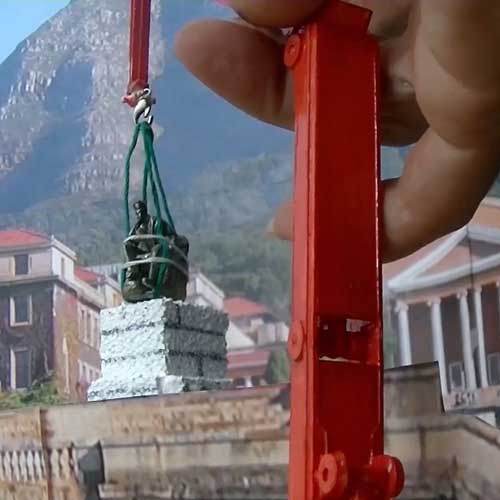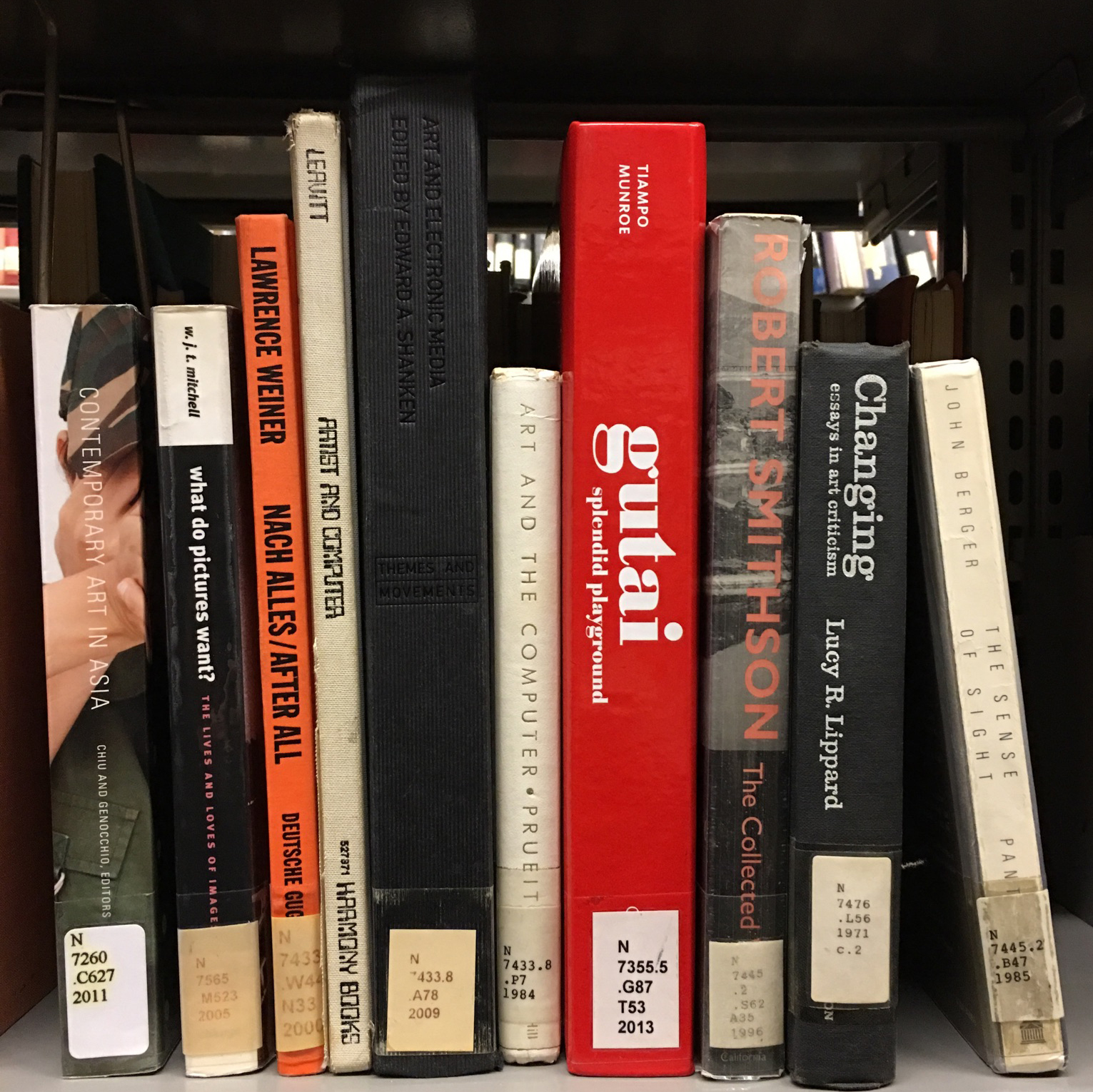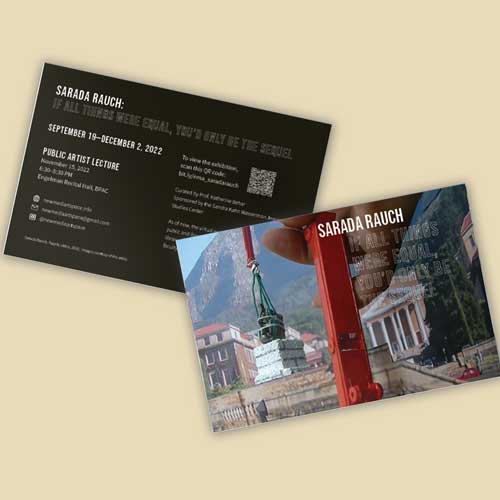Past Exhibition
Sarada Rauch: If All Things Were Equal, You'd Only Be the Sequel
September 19 - December 2, 2022 – Archived
The online exhibition Sarada Rauch: If All Things Were Equal, You'd Only Be the Sequel was on view September 19 - December 2, 2022, presented by the New Media Artspace at Baruch College and generously sponsored by the Sandra Kahn Wasserman Jewish Studies Center. The exhibition has been archived online. Click here to view it.
Curatorial Statement
The New Media Artspace is proud to present Sarada Rauch: If All Things Were Equal, You’d Only Be the Sequel, a solo exhibition of eight single-channel moving image works by the New York-based artist. Rauch’s projects are
frequently set at intimate scales of personal engagement —a tabletop, a tablet, a domestic tableau, a neighborhood. At a time when the world’s problems often seem inconceivably large, Rauch scales everything down into a framework
where intervention becomes possible. With deceptively modest means, they craftily manipulate things in the troubled present to arrive at impoverished but hopeful images of how the world might be otherwise. Even while Rauch dares to imagine
“If All Things Were Equal,” their works unflinchingly acknowledge a present reality in which that is far from being the case.
A homespun aesthetic runs throughout Rauch’s work. As an interdisciplinary artist, Rauch
has a practice that seems to swallow whole whatever media lie in their path. They employ animation, video, performance, photography, poetry, music, and sculpture, overflowing these categories freely. Several of the video works in If All
Things Were Equal derive from an art album, In the Realm of a Dying Star: Side A, featuring Rauch’s own music. Like their animation style, the music makes self-aware reference to Rauch as a one-person band, remixing
themself and filling every role. Endearingly underproduced, the songs at first seem to deliver anti-capitalist un- slickness, flying in the face of mass-production norms. This could be interpreted as an anarchist commitment to
self-sufficiency, but while the work operates this way, it is more complex, too. Rauch is aware that even their restrained production values nevertheless rely on technologies that are themselves the spoils of war and products of human
suffering. They voice this critique in Second Law of Thermodynamics, which pans through a domestic interior across a countertop littered with everyday items that in Rauch’s words, “hold a history of exploitation [...
including] merchandise made on the backs of human rights abuses, oil and gas, and the militarization of the police.”1 Even Rauch’s homemade works unfurl tentacles outward into networks of allyship and complicity.
Perhaps
for this reason, Rauch constantly reminds their audience that they participate in every element seen or heard in their work. Rauch leans heavily on “tricks” of the eye, literally reframing what we see. Yet, Rauch is continually
showing their hand, exposing their methods and undoing their magic, while nevertheless keeping us captivated. In the title of one work, Rauch baldly admits “I’ve Got a Hand in It.” They imply that they—and by
extension we—are culpable for suffering on the other side of the world, as distant as it may seem from their comfortable life. At the same time, this phrase also means that their hand is literally in their work, touching their images,
and pointing to themself as creator in their role as an artist.
What is the role of an artist? For Rauch, it seems to be in experimentation, in messing around sometimes playfully but with serious intent. It is also in dogged
introspection, speaking hard truths to themself, and—crucially—with this information crafting political consciousness. Against the odds, the handmade imagery and self-styled soundtracks in Rauch’s works, coupled with their
coyly outspoken political awakening, leads to enfranchisement, and their preoccupation with apocalyptic end times retains optimistic opportunity. The exploit at the heart of Rauch’s practice seems to be this lesson: Political identity
becomes a matter of craft, of self- fashioning, and of pragmatic agentic intervention. Politics is in the craft of making do and making better by whatever means are available at hand. If this is so, an artist’s role is to take things as
they are quite at hand, making them available to manual manipulations, and making the present (even the doomed present) malleable.
Rauch shows their hand again and again, with examples of their manipulative technique (or anti-
technique) that undercut the investment in illusion that undergirds media consumption habits. The opposite of keeping one’s cards close to one’s chest, showing your hand gives away for free the value media purport to hold (over
us). For instance, Rauch’s life-size index finger interrupts the collage-based animation Middles. Pointing to the center of the work, the finger disrupts its illusion, and points out a lesson in perspective that applies equally
to
philosophy, physics, and optics. Meanwhile, in the video work Gravity, a jokey premise—children’s make-believe and obvious greenscreen—manages to generate real joy and potential by liberating kids to fly away and
soar above
it all. The joy is as real as the manipulation is obvious; the children’s knowing participation in faking it results in genuine smiles. In both cases, Rauch leverages a medium at the precise point where it is conventionally most
manipulative—that is, where it convinces us to buy in to its seamlessness. Rauch has discovered that that is also exactly where the medium is most available to manipulation. The apparent seamless of images is really a seam that can be
opened onto another world.
In the first work in the exhibition, Topple, the political relevance of Rauch’s anti-technique is at the fore. Rauch recreates monuments of patriarchal and racist oppressors at miniature
scale and
shoots them against diorama-like backgrounds of the public spaces where they were installed. Then, with their full-scale hand and a bit of string, they topple them one by one. Showing their hand, they seem to say, “It can be as easy as
that.”
- Katherine Behar
1Sarada Rauch, “Second Law of Thermodynamics.” http://saradarauch.com/2ndlawthermo.html. Accessed September 1, 2022.
Artist Bio
Sarada Rauch is an artist, poet and musician born in Los Angeles and based in Brooklyn. Their work reenacts popular media and personal experience to explore the construction of histories and Unbelonging. Sarada exhibits, performs and screens internationally in spaces such as The Drawing Center, New York; Hessel Museum of Art, Hudson; Museum of Contemporary Art, Miami; Central St. Martins, London; La Conservera Center of Contemporary Art, Cueti; RISD Museum, Providence and Aesthetica Short Film Festival. Artist residencies they have participated in include Open Sessions at the Drawing Center, New York; The LMCC Swing Space, New York; Lakkos Residency, Heraklion, Crete; _Hannacc, Barcelona; Greatmore Studios/Triangle Network, Cape Town; amongst others, and they received the BBK Saxony Fellowship in Leipzig. They are an Associate Professor of New Media and Technology at LaGuardia Community College.
This exhibition is generously sponsored by the Sandra Kahn Wasserman Jewish Studies Center under the directorship of Dean Jessica Lang.
Sarada Rauch: If All Things Were Equal, You’d Only Be the Sequel is curated by
Katherine Behar, Associate Professor in the Fine and Performing Arts Department in the Weissman School of Arts and Sciences, Baruch College, CUNY and is produced by the New Media Artspace Student Docent Team. The exhibition is made possible
further by support from the Baruch Computing and Technology Center (BCTC), the Weissman School of Arts and Sciences, and the Newman Library. All images appear courtesy of the artist.
Visit Us
Public Hours
The gallery is open to the public by appointment during regular library hours. Please contact newmediaartspace@gmail.com to arrange a visit.
Location
151 E. 25th StreetNew York, NY 10010
Located in the Newman Library
About Us
The New Media Artspace is a teaching exhibition space in the Department of Fine and Performing Arts at Baruch College, CUNY. Housed in the Newman Library, the New Media Artspace showcases curated experimental media and interdisciplinary artworks by international artists, students, alumni, and faculty.
Follow Us
Feedback
Have thoughts about our exhibitions? Leave a comment here!





